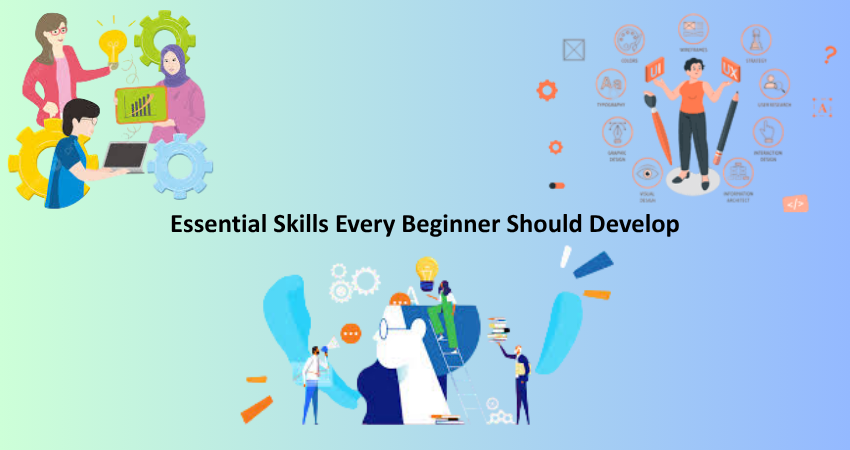
Introduction
Designing User Experience (UX) and User Interface (UI) is really basic to any aspect of the digital world. From apps on the smartphone to the websites you view day by day, UX / UI design shapes your interaction with technology. The moment you realize this, the importance of user-centered design drives the market for skilled professionals like UX/UI designers up. Still, it’s a little overwhelming for beginners to get into the world of UX/UI. There are thousands of tools; there are tons of jargon; there’s design philosophy and career paths, all different; and all have their own learning curve. This article is going to be a complete guide for beginners on UX/UI design.
Be it switching contexts, starting from scratch, or dabbling in UX/UI in a hobbyist way, this article basically will give you the basic ideas. What can continue is different aspects like UX and UI, skills to build, common tools, and starting to develop your first portfolio. Actually, anyone can start to build a good career in UX/UI design with the right mindset, wanting to learn, and some basics. In the end, you’ll have a clearer picture of how to navigate the early stages of your UX/UI journey after reading this article.
Understanding UX vs. UI Design
UX Design: Crafting the User Experience
UX design is concerned with the design of the user-experience across which users navigate a product or a service, not only the visuals but also the functionality, the interactional flow, and the intuitiveness for users to achieve their goals. So, one could say that empathy is at the core of UX. Designers need to put themselves in the user’s position and have the ability to critically think about their users’ needs, frustrations, and behaviors. This is the translation of research into user personas into user journey mapping, through to ongoing testing with feedback iterating on any solution.
The UX process starts off with discovery and research ways to garner data from interviews, surveys, and usability testing to even a competitor analysis. This is the very research that feeds into the wireframing, user flows, and prototypes that should be aimed at a really functional and pleasurable product. UX designers work side by side with product managers, developers, and UI designers to nurture the final product to interact seamlessly with both business goals and user expectations. An important first step into UX design for a beginner is to develop that problem-solving attitude and learn to ground decisions in data as opposed to personal preference.
UI Design: Bringing Interfaces to Life
While UX design focuses on a product’s functionality, UI design centers on how it looks and feels. UI designers take wireframes and prototypes from initial conceptualization to high-fidelity visual designs that fit into the broader context of the product’s branding and identity: color palette, typefaces, spacing, iconography, and the same consistent visual system all across the touchpoints. UI design is highly detail-centered work that requires a sound understanding of the visual hierarchy, balance elements, and principles of user interface design.
A UI is not just meant to give a product aesthetic appeal: it makes it usable and accessible to varied audiences. Good UI design builds a digital experience that lets a user glide effortlessly through the process, by highlighting clarity and consistency. Figma, Adobe XD, or Sketch do the interface design rounds out the tools of choice for UI designers to create and collaborate on designs. As a novice, UI design is best started with learning about layouts, followed by play-testing style guides and critically analyzing illustrious design patterns. These UI-techniques indeed enhance the articulation of ideas while working in tandem on product teams.
Essential Skills Every Beginner Should Develop

Research, Empathy, and Communication
User research is a vital part of any UX or UI design. Research helps you learn who your users are, what they want, and what problems they are trying to solve. Teaching beginning designers how to run interviews, surveys, and usability tests will give them a great start in understanding user behavior. This user research is the path to fostering empathy, which is one of the core pillars of UX. Once you foster empathy, you can stand up for users in design decisions, ensuring that the product effectively achieves their goals. Learning about users includes mapping the journey, recognizing pain points, and brainstorming solutions that lead to gratifying experiences.
As important as achieving results is the capacity to communicate one’s findings and design rationale. Often, UX/UI designers find themselves interfacing with stakeholders, developers, and other team members, so one clear articulation of why a design decision is made becomes all the more significant. For novices, framing how to present design ideas or give constructive criticism-and telling stories through design-improves collaborative skills. And communications build over time-they’re what source-transform good design into the great. Whether it’s writing a user research summary, leading a design critique, or other acts, excellent communication will support your entire UX/UI journey.
Visual Design, Prototyping, and Tools
Proficiency in visual design is another one of the core skills aspiring UI designers should have. It’s all about how to apply color theories and balance visual elements, spacing, and alignment because they can have an effect either positively or negatively on the clear and appealing aspects of a design. All these rules keep the interfaces beautiful as well as functional. Beginners can look at very well-designed apps and websites, deconstruct and recreate the layouts, which would do wonders for the design eye. Applications such as Figma, Adobe XD, or Canva are more or less beginner-friendly in a sense that they really help you test and practice.
Prototyping refers to creating interactive representations of your design. Prototypes will help stakeholders visualize how the product will work, and early feedback can be obtained before development starts. Tools such as Figma and InVision make it easy to create interactive flows simulating real user experiences. Instead of jumping into complicated prototyping, students in their introductory subject will use low-fidelity wireframes and build toward clickable prototypes. As it matures, it can be complemented with lessons on integrating animations, transitions, and responsive behaviors. Visual design and prototyping skills will bring your UX research to life in a tangible, testable way.
Building Your First UX/UI Portfolio
Starting Small: Personal Projects and Redesigns
A solid portfolio is a must-have for every aspiring UX/UI designer. It displays not just your visual design skills but also how you went through the problem-solving process, conducted research, and told a story. As a beginner, there might not be any client work or internships to show off yet, and that’s just fine. You can basically start by working on some of your personal projects or perhaps redesign existing applications or websites. Pick platforms or products you like to use often, pick out what works and what doesn’t, and then follow through the UX and UI process from start to finish.
Documenting what you think is just as deserving as the final designs used. Case studies can walk us through the problem, your research, what steps you took, and how your solution furthers improving the experience. Even a simple redesign of a login screen or mobile menu speaks further of your knowledge regarding user needs, layout, and visual hierarchy. Web platforms like Behance, Dribbble, and personal Websites for showcasing work are all good options. Working on smaller projects allows you to gain traction, strengthen your design voice, and build your self-confidence while preparing for bigger projects or freelance opportunities.
Getting Feedback and Iterating
The process of design involves a lot of iteration; therefore, it is imperative to learn to seek out and apply feedback for growth. Displaying your work to peers or imparting it before mentors or by sharing it with online communities like Reddit’s r/UXDesign or Designer Hangout will give you various insights. Welcome criticism and recognize that feedback is not a commentary on your skills but rather an opportunity to sharpen them. With practice, sharing your work will lead to better self-evaluation and improved overall performance. The regularity of these feedback loops replicates working conditions and trains you for collaboration within a team.
Iteration is key for creating conscientious user-centered designs. Rarely is the first idea ever the best. Testing of prototypes, collecting user input, and adjusting designs accordingly should become a habit. This instills resilience and halts embracing a mentality of continuous learning. On the contrary, in an impromptu setup, beginners who accept feedback and iteration early on will snowball into rapid development and accumulation of an impressive portfolio. These very projects, later on, may stand as an unmistakable testament to your active skill set and applicability for improvements based on tangible insights-a quality much sought after by the industry and clientele.
Career Paths and Continued Learning

Exploring Job Roles in UX/UI
While developing your foundation in UX/UI design skills, be on the lookout for different pathways that exist in this industry. The UX/UI design profession is broad and focuses on specialized roles such as UX researcher, UI designer, interaction designer, information architect, and product designer, which together highlight different aspects of the user experience-from usability testing to stunning visual interface design. To a novice, exploring all these positions through internships, job shadowing, or personal projects should provide clarity regarding long-term career decisions and how to select a specific path forward.
Knowing the difference between roles makes it easier to tailor your training and further hone your portfolio. The courses you take and what you include in your portfolio should reflect your career interest: If solving problems and analyzing data come to your mind, why not target your skills toward being a UX researcher? If visuals, look, and feel are more your calling, pursue a UI design career. Many designers start off as generalists for a while before they might niche down into specialized roles. So knowing about these opportunities early on will help you develop relevant skills while still carrying the flexibility to follow industry demands.
Lifelong Learning and Staying Updated
The world of UX/UI design is most certainly dynamic and fast-paced. The emergence of new tools and trends and best practices never ceases, and a successful designer practices lifelong learning in these areas. For beginners, this would surely mean getting into the habit of reading industry blogs, attending design webinars, following industry experts online, and participating in design challenges. This activity will keep you updated on the very latest methods and will allow for testing out some of those cool techniques that just might make you one of the top candidates in the job market.
Online platforms like Coursera or LinkedIn Learning as well as YouTube have many valuable courses covering both basic and advanced topics in design. Those familiar with the old design principles may refer to books like “Don’t Make Me Think” by Steve Krug or “The Design of Everyday Things” by Don Norman. Such principles will make your design thinking more comprehensive. Having a growth mindset will be useful for sharpening your skills to be relevant and competitive whether the industry changes in part or whole. For newbies, learning is probably one of the best investments for confidence and building a modern, innovative designer in them.
Conclusion
The wide road into UX/UI design can appear frightening, yet it is also full of creative, problem-solving, and personal growth opportunities. Differentiating between UX and UI, acquiring the basic skills of research, communication, visual design, and prototyping, and building a strong portfolio is critical in beginning to call oneself a designer. With hard work and a curious mind, a newbie can already begin affecting the digital design world.
The dynamic field of UX/UI is ever-changing; those who maintain curiosity, accept feedback, and strive for improvement are the ones who have longer careers. Everybody was a beginner. With every project, every critique, every iteration of design, you will increase not only in skill but in confidence. Continue learning. Continue designing. Most importantly, continue placing emphasis on the user for every creation. This is the very beginning of your journey, with possibilities beyond measure.